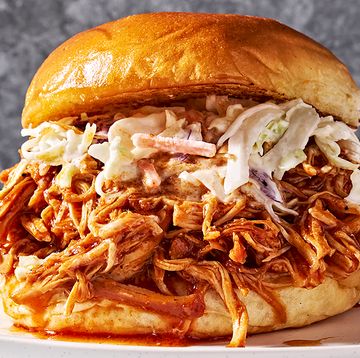
Homemade croissants are a magical thing, thanks to a fairly detailed and time-intensive process. To make these flaky, buttery pastries the traditional way, you’ll need a lot of time, even more butter, and a fair amount of counter space. Our perfect homemade recipe is truly something special, but if you’re looking to dip your toe into the homemade pastry world, then this recipe is where you should start. It includes a few shortcuts and hacks that make it a great beginner recipe. Plus, it’s about as quick as homemade croissants can be. Stepping into a bakery is still faster, but that first fluffy, flaky bite for breakfast makes it all worth it.
In this recipe, the dough is basically a borrowed pie crust technique, cutting large chunks of cold butter into flour and skipping the intimidating laminating process, i.e., folding endlessly around a wide slab of butter. Tip: When cutting the butter into the flour, you want to keep the chunks large and flat, not pea-sized like you might do for a pie crust. The larger the butter chunks, the flakier your croissants will be.
The dough has a few rest times that can stretch longer if needed, allowing you to start and stop at your own pace—you’re not at the mercy of your bake here. My top recommendation? While your croissants are chilling, make a batch of homemade jam to go with.
Made this shortcut recipe? Let me know how it went in the comments below!
Ingredients
- 4 cups
(480 g.) all-purpose flour, plus more for dusting
- 1/3 cup
(67 g.) granulated sugar
- 2 tsp.
kosher salt
- 2
(1/4-oz.) packages instant yeast
- 1 1/2 cups
(3 sticks) unsalted butter, cut into large pieces, cold
- 2/3 cup
(or more) cold milk
- 6 oz.
chopped chocolate or chocolate baking batons, for chocolate croissants
- 1
large egg
Directions
- Step 1In a large bowl, whisk flour, sugar, and salt. Add yeast and whisk again to combine. Add butter and toss to coat. Using your hands, cut butter into flour, making sure to toss and keep all butter coated in flour as you go; it should remain large and none should be smaller than a walnut half.
- Step 2Add milk and mix with your hands until a dough starts to form. Add more milk, 1 Tbsp. at a time as needed, until dough just barely holds together when squeezed. (It's better to err on the side of the dough being too dry rather than too wet.)
- Step 3Turn out dough onto a work surface and fold it over itself a couple of times to bring it together and make sure there are no large dry spots. Pat into a large square and wrap with plastic wrap. Refrigerate at least 1 hour and up to 12.
- Step 4On a lightly floured surface, roll dough into a rectangle about 15" x 12". With the longer end closest to you, fold the right side into the middle, then fold the left side over, like a letter. Rotate dough 90° so seam faces you.
- Step 5Roll dough to a 15" x 12" rectangle again and repeat folding process. Wrap in plastic wrap and refrigerate 30 minutes.
- Step 6Roll dough to a 15" x 12" rectangle again and repeat folding process. Wrap in plastic wrap and refrigerate until cold, at least 4 hours and up to overnight.
- Step 7Let dough sit at room temperature 10 minutes. On a lightly floured surface, roll dough to a 20" x 14" rectangle. If dough stretches back or doesn’t seem to be rolling easily, let it rest for a few minutes, then continue rolling. (You may need to let the dough rest a couple times during this process). After dough reaches the desired length, let it rest 5 minutes to prevent from shrinking too much while cutting.
- Step 8With the longer end facing you, cut dough in half lengthwise so that you have 2 pieces that are 20" x 7".
- Step 9For traditional croissants, cut into triangles that are 5" wide at the base. To do this, place your ruler at the base of the dough. Using a knife or bench scraper, line it up and angle down toward the 5" mark on the ruler. Alternate making the base of the triangle at the bottom or top of dough.
- Step 10In the center of the base of each triangle, cut a 1"-deep slit and fan apart to create an exaggerated “V” in the cut. (This helps give the croissant a longer, better shape.) Gently tug and stretch the point of the triangle out a little. Starting at the base, loosely roll toward the tip, making sure the tip ends up completely under the croissant. This will help ensure the croissant holds its shape and rises tall during baking.
- Step 11For chocolate croissants, cut into 4"-wide rectangles. Place some chocolate (or 1 baking baton) about 1 1/2" up from the bottom of the rectangle, then fold dough over chocolate once. Place more chocolate right at the fold, then continue to roll until seam is underneath.
- Step 12Place croissants on 2 large parchment-lined baking sheets. Cover with kitchen towels and let rise in a warm spot until puffy and slowly springs back when poked with a finger, but not quite doubled in size, 3 to 4 hours.
- Step 13Arrange racks in upper and lower thirds of oven; preheat to 425°. In a small bowl, beat egg with 1 Tbsp. water. Brush tops of dough with egg wash.
- Step 14Bake croissants for 8 minutes. Reduce oven temperature to 375° and rotate baking sheets top to bottom. Continue to bake until deeply golden and puffed, 14 to 17 minutes. Let cool 10 minutes.













